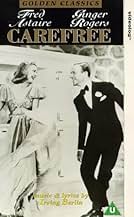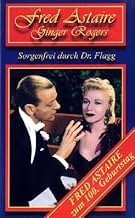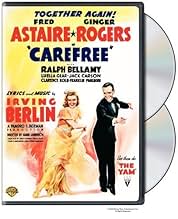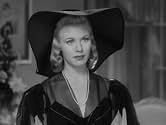IMDb RATING
6.9/10
4.5K
YOUR RATING
A psychiatrist falls in love with the woman he's supposed to be nudging into marriage with someone else.A psychiatrist falls in love with the woman he's supposed to be nudging into marriage with someone else.A psychiatrist falls in love with the woman he's supposed to be nudging into marriage with someone else.
- Nominated for 3 Oscars
- 3 wins & 4 nominations total
The Robert Mitchell Boy Choir
- Vocal Ensemble
- (scenes deleted)
- (as Robert B. Mitchell and his St. Brendan's Boys)
Harry A. Bailey
- Sponsor
- (uncredited)
Bobby Barber
- Minor Role
- (uncredited)
Cliff Bergere
- Minor Role
- (uncredited)
Ralph Brooks
- Country Club Guest
- (uncredited)
James P. Burtis
- Glass Truck Driver
- (uncredited)
Harry Campbell
- Minor Role
- (uncredited)
James Carlisle
- Country Club Guest
- (uncredited)
Charles Coleman
- Doorman
- (uncredited)
Featured reviews
In the eighth of ten screen appearances together, Fred Astaire and Ginger Rogers were firmly established as Hollywood's leading dancing pair. What is interesting about this 1938 entry is that it feels less like a musical and more like a screwball farce with musical interludes composed by Irving Berlin. The other less tangible aspect is that one can sense the two were growing in different directions at this particular juncture. While Astaire is still his debonair, nimble-footed self and as immaculate a dancer as ever there was on screen (watch his golfing solo for proof), Rogers seems to find surer footing as a crack comedy actress this time around. That's not to say they don't create magic when they dance. Indeed they do, an especially wonderful treat captured crisply on the newly released DVD, but you can somehow feel the beginning of the end.
Credited to no less than seven writers, the nonsensical plot focuses on singer Amanda Cooper, a radio star who has broken off her engagement three times to Stephen Arden, a rich bon vivant who spends an inordinate amount of time at the country club. Concerned about her flightiness but convinced that she is the one for him, he consults with his psychiatrist friend, Dr. Tony Flagg. Upon Stephen's insistence, Amanda goes to see Tony, and things immediately start off on the wrong foot when she overhears some of Tony's insensitive remarks about women on a dictaphone. Amanda and Tony eventually bury the hatchet over an accident-prone bike ride and become friends. You can probably figure out the rest of the complications that occur.
Even though Astaire acquits himself well as Tony (a rare role where he is not a professional entertainer) and Ralph Bellamy gamely plays yet another third-wheel role as Stephen, it is really Rogers who dominates the comedy scenes with her sharp timing and spirited manner. Moreover, the dance numbers don't disappoint with a lovely dream sequence set to "(I Used to Be) Colorblind" and a concluding romantic pas-de-deux cast under a hypnotic spell in "Change Partners". But my personal favorite is "The Yam", a jazzy, acrobatic number meant to replicate the late-thirties dance crazes. With Astaire bouncing Rogers on a series of cushiony chairs and then gracefully twirling her airborne over his table-affixed leg, this one may be my favorite of all their screen dances based on their sheer energy and athleticism.
For whatever reason, the supporting cast is not nearly as memorable as other Astaire-Rogers films at the time with Luella Gear looking a little too young as Amanda's Aunt Cora, Clarence Kolb as crabby Judge Travers and a young Jack Carson as Tony's helpful clinic assistant (doing a pretty decent Japanese accent over the phone). While the use of psychoanalysis must have been quite novel at the time, it feels rather clichéd now. Nonetheless, Astaire and Rogers still make magic regardless of the story contrivance. The 2006 DVD contains two vintage extras a twenty-minute, tap dancing short called "Public Jitterbug #1" about an outlaw jitterbug dancer, and a brief cartoon, "September in the Rain", where famous icons displayed on packaged foods of the day come to life.
Credited to no less than seven writers, the nonsensical plot focuses on singer Amanda Cooper, a radio star who has broken off her engagement three times to Stephen Arden, a rich bon vivant who spends an inordinate amount of time at the country club. Concerned about her flightiness but convinced that she is the one for him, he consults with his psychiatrist friend, Dr. Tony Flagg. Upon Stephen's insistence, Amanda goes to see Tony, and things immediately start off on the wrong foot when she overhears some of Tony's insensitive remarks about women on a dictaphone. Amanda and Tony eventually bury the hatchet over an accident-prone bike ride and become friends. You can probably figure out the rest of the complications that occur.
Even though Astaire acquits himself well as Tony (a rare role where he is not a professional entertainer) and Ralph Bellamy gamely plays yet another third-wheel role as Stephen, it is really Rogers who dominates the comedy scenes with her sharp timing and spirited manner. Moreover, the dance numbers don't disappoint with a lovely dream sequence set to "(I Used to Be) Colorblind" and a concluding romantic pas-de-deux cast under a hypnotic spell in "Change Partners". But my personal favorite is "The Yam", a jazzy, acrobatic number meant to replicate the late-thirties dance crazes. With Astaire bouncing Rogers on a series of cushiony chairs and then gracefully twirling her airborne over his table-affixed leg, this one may be my favorite of all their screen dances based on their sheer energy and athleticism.
For whatever reason, the supporting cast is not nearly as memorable as other Astaire-Rogers films at the time with Luella Gear looking a little too young as Amanda's Aunt Cora, Clarence Kolb as crabby Judge Travers and a young Jack Carson as Tony's helpful clinic assistant (doing a pretty decent Japanese accent over the phone). While the use of psychoanalysis must have been quite novel at the time, it feels rather clichéd now. Nonetheless, Astaire and Rogers still make magic regardless of the story contrivance. The 2006 DVD contains two vintage extras a twenty-minute, tap dancing short called "Public Jitterbug #1" about an outlaw jitterbug dancer, and a brief cartoon, "September in the Rain", where famous icons displayed on packaged foods of the day come to life.
this is one of my favorite fred astaire/ginger rogers films. it's highly amusing how she toys with him at the beginning of the film, and then once he begins hypnosis, they have one of the best dance scenes i've ever seen between them. as always, their magic together is astounding.
Tony Flagg (Fred Astaire) agrees to psychoanalyze the girlfriend of his pal Steve (Ralph Bellamy) because she can't make up her mind as to whether or not she wants to marry him. The girlfriend, Amanda (Ginger Rogers), decides in short order that she actually loves Tony, but he has decided she's perfectly normal and doesn't need his help. So she contrives a ridiculous dream so that he thinks she is abnormal and will continue to treat her.
This film should have been renamed "Conscience Free" as none of the three central players seems to have one. Astaire comically abuses his license to heal to hypnotize Rogers to try to control her emotions. When he realizes he's fallen for her, he tries to re-direct her affections for Bellamy to him. Rogers, when told under hypnosis to follow every impulse, escapes Astaire's office before she can be taken out of her trance, decides it would be fun to knock the canes away from old people and watch them fall down and to throw rocks through windows. And Bellamy, upon hearing that Rogers really loves Astaire, and that she is only marrying him as a result of hypnosis, is perfectly OK with that.
The Irving Berlin music, what there is of it, is fine. But there is little of the usual chemistry between Astaire and Rogers. Bright spots include an early career appearance by Jack Carson showing his flair for comedy and Clarence Kolb as a family friend and judge acting like The Monopoly Man personified. This was the only Astaire & Rogers film to lose money at the box office.
This film should have been renamed "Conscience Free" as none of the three central players seems to have one. Astaire comically abuses his license to heal to hypnotize Rogers to try to control her emotions. When he realizes he's fallen for her, he tries to re-direct her affections for Bellamy to him. Rogers, when told under hypnosis to follow every impulse, escapes Astaire's office before she can be taken out of her trance, decides it would be fun to knock the canes away from old people and watch them fall down and to throw rocks through windows. And Bellamy, upon hearing that Rogers really loves Astaire, and that she is only marrying him as a result of hypnosis, is perfectly OK with that.
The Irving Berlin music, what there is of it, is fine. But there is little of the usual chemistry between Astaire and Rogers. Bright spots include an early career appearance by Jack Carson showing his flair for comedy and Clarence Kolb as a family friend and judge acting like The Monopoly Man personified. This was the only Astaire & Rogers film to lose money at the box office.
Fred Astaire and Ginger Rogers star in this delightful romantic musical comedy with a twist on the usual Fred and Ginger plot. Though odd and short in the musical number department, this teasing romantic romp features some of their best dancing and good humor to boot. Ginger Rogers is nothing short of stunning in this picture and Mr. Astaire's feet never touch the ground. Definitely their most underrated film.
there is something specific about watching fred astaire and ginger rogers that just makes you want to dance. i think it's because they make it look so damn fun. and they are just so astonishingly good!! the plot here is a tad crazier than, say "top hat", and therefore that much less believable (come on ... going all out with freud and hypnosis, but then again that's just speaking from what is known today, so no problem letting that pass). irving berlin's music is a hoot at times (there's a song about yams) and classic and familiar at others ("change partners") and ginger rogers is nearly at her sassy best.
Did you know
- TriviaThis was the first Fred Astaire-Ginger Rogers film to lose money on its initial release. It lost $68,000 (~ $1.48M in 2024) for RKO according to studio records.
- GoofsIn the golf sequence, one of the five golf balls thrown on the solid base has rolled off onto the grass. After Fred has hit the first four balls, the camera cuts to a new angle and the last ball has moved from the grass to the solid base.
- Quotes
Stephen Arden: [drunkenly] Oh, uh, could you give me a little information?
Doorman: Yes sir.
Stephen Arden: Thank you.
[walks away]
- Crazy creditsDuring opening credits, a pair of hands finger-paints names, pauses, wipes them out, and writes the next set of names several times.
- ConnectionsFeatured in Fred Astaire: Puttin' on His Top Hat (1980)
- SoundtracksSince They Turned Loch Lomond into Swing
(1938) (uncredited)
Music by Irving Berlin
Danced by Fred Astaire
- How long is Carefree?Powered by Alexa
Details
Box office
- Budget
- $1,253,000 (estimated)
- Runtime1 hour 23 minutes
- Color
- Aspect ratio
- 1.37 : 1
Contribute to this page
Suggest an edit or add missing content


































